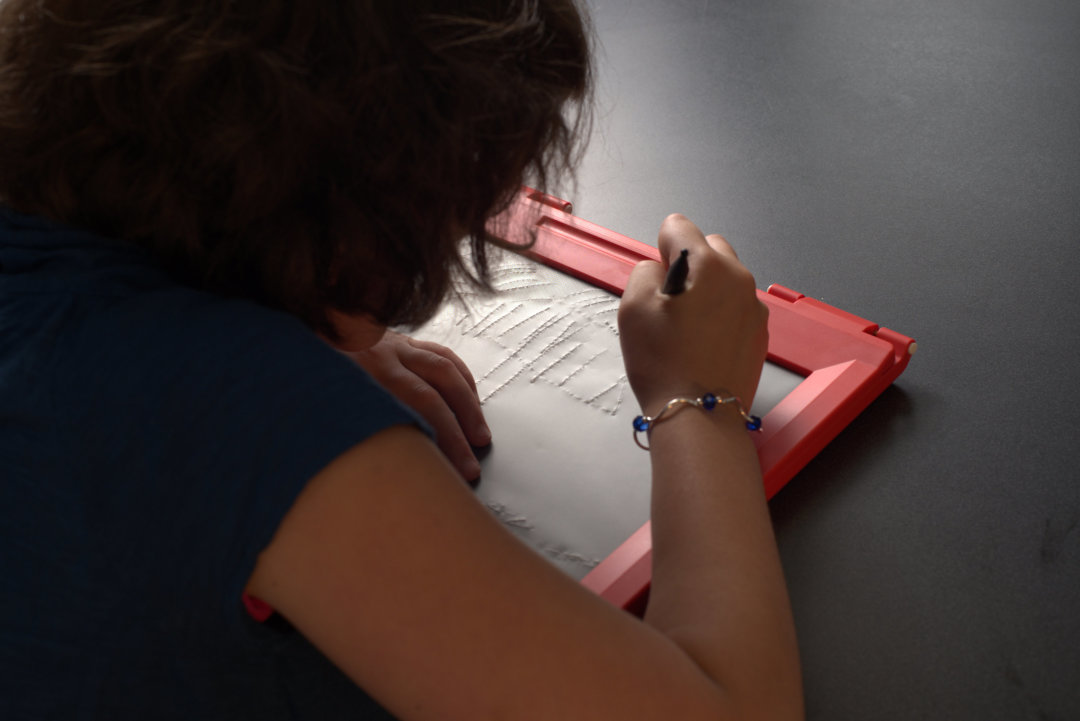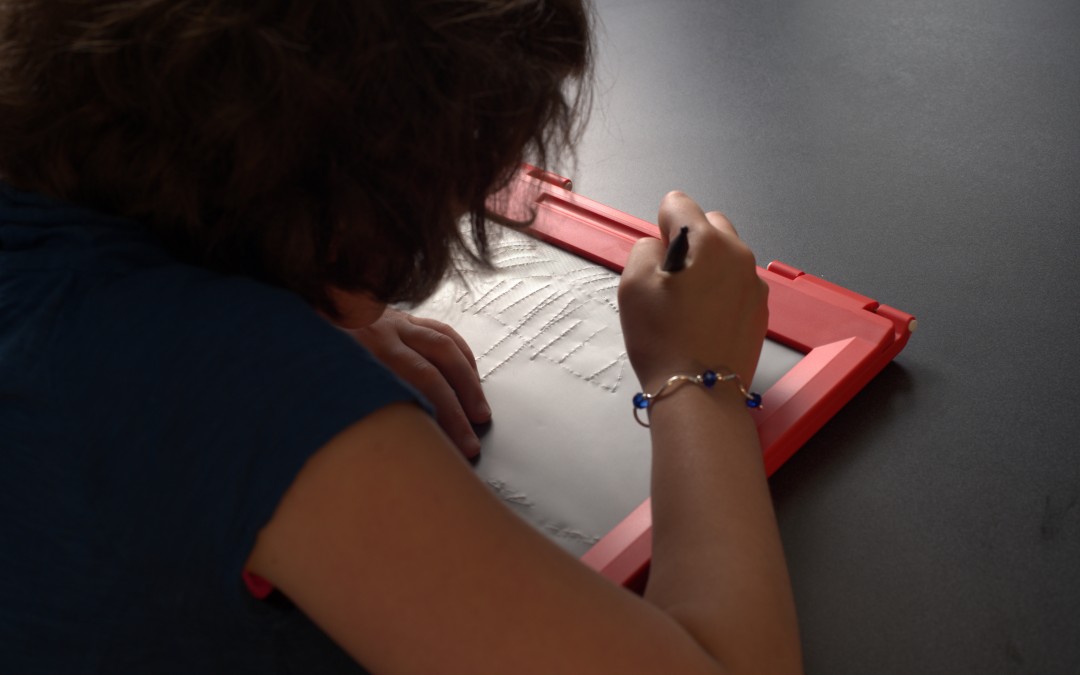
A young girl making tactile graphics on a red intact sketchpad
First a disclaimer. We at E.A.S.Y. LLC have probably taken note of the tactile graphics skills and attitudes of close to two hundred BLV people, and half again as many sighted individuals with personal and professional ties to the BLV world. Despite this exposure, I can’t claim to be a scholar of this topic. I’m not a perceptual psychologist and I haven’t done controlled studies of the drawing capabilities of people with limited or absent vision. (Partly, that’s because the 24-7 task of building our start-up and developing our products has made it difficult to find the time for research – a painful truth for a life-long academic.) So there; I’ve implicitly apologized for any inaccurate observations or naive interpretations presented below. Reader beware.
Mike Coleman from the UVM Engineering Faculty; Susan Edelman from Education; Gayle Yarnall, access technology consultant and advocate in Massachusetts; and I do have a small pilot project underway, funded by the UVM REACH Program. We’re trying to get a sense of the major influences on kids’ ability to explore and understand tactile graphics, and their skill in making original raised-line drawings. We’re doing home-made evaluations of a dozen BLV children and youth in Vermont, New Hampshire and Massachusetts with the cooperation of numerous teachers and parents. In these trials we are sampling the tactile, spatial and linguistic experiences and abilities of BLV youngsters in the hopes of predicting what skill with tactile graphics might reasonably be expected from each of them.
By the end of this week (April 25th six of our participants, ranging in age from 3rd that the primary outcome of this study will be revision of our assessment techniques; statistically valid conclusions about the predictors of tactile graphics skill will have to wait. But from my hours with the first subjects, some recognitions and insights have jumped out that may be worth reporting here. ) we’ll have conducted two-hour assessment sessions with the first grade to mid-high school. It’s quickly becoming clear
The potential content of blind children’s drawings, in contrast, becomes accessible through touch, sound and the descriptions provided by others.
The first is the simple awareness that BLV “artists” (sounds better than “draw-ers”) are the same as their sighted peers in two respects, and very different in a third. Every young person’s ability to draw and to understand drawings is determined in part by her/his individual characteristics – such as talent, drive, attitude, competitiveness with peers, determination to keep up in school, and more. These internal factors distinguish kids from each other whether they’re sighted or BLV. And secondly, there are stages of development. For sighted and BLV young people alike, the maturation of motor and perceptual systems proceeds, driven by nature and expectations, setting a limit on graphics skills at any age.
But the difference between kids who see and kids who don’t, of course, is that for sighted children the shapes, arrangements, interactions and identities of the subject matter for drawing are on continuous display, in every direction and at every distance, at every waking moment. The potential content of blind children’s drawings, in contrast, becomes accessible through touch, sound and the descriptions provided by others. It is the richness or impoverishment of the resulting awareness and knowledge – and its effect on development – that we are trying to sample with our Background Assessment and relate to tactile graphics skills.
From our first six kids, all marvelous and each surprising in her/his own way, a consistent observation is the in-consistency of their familiarity with our sample of objects from daily life. There’s the ninth grader who identified a cooking strainer as a tennis racket. And the third grader who knew a monkey wrench by touch and provided a marvelous verbal description. And the sixth grader who identified the shingles on the roof of doll house as stairs. And the children who did, or didn’t, recognize a model of a school bus. How could these disparities of experience not have a significant impact on what can be expected as these children draw and explore tactile graphics? … and expected from them in school where curricular expectations are so much more uniform than the kids’ backgrounds?
Another observation, the last for the time being, is the difference among my new young friends, even those of nearly identical pre-teen age, in the development of their motor control. Posed as a question, how can we expect them to meet standardized drawing requirement of ninth-grade geometry, when some still hold a drawing stylus in their fist while others show the finesse and dexterity that comes from practice? How can we expect spatial sense sufficient for accurate drawing from the middle school student who has almost no control of the direction she rolls a ball?
I’ve asked this as a rhetorical question, but one answer, perhaps obvious, emerges. Our observations so far support the attitude I’ve heard from many of our TVI friends: making and reading tactile images best begins in toddlerhood – about the same age when sighted children are first scribbling with crayons and markers. Quoting the E.A.S.Y. LLC mantra (and paraphrasing typical election day advice): “Draw early; draw often”.
More observations and thoughts to come as this study progresses; please stay tuned.


Recent Comments